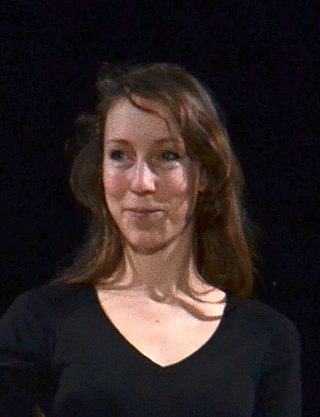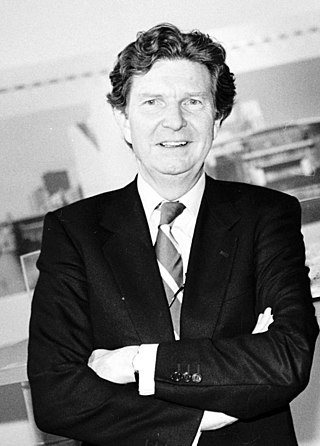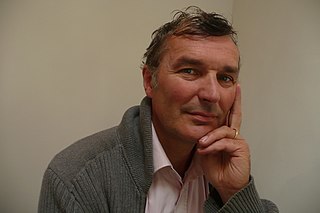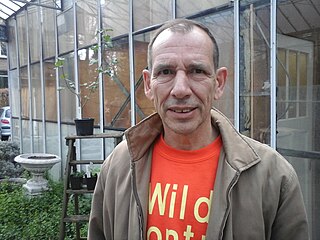
Albert Carel Willink was a Dutch painter who called his style of Magic realism "imaginary realism".
ArtEZ University of Arts is an art academy in Netherlands. ArtEZ combines several art institutes and art disciplines with branches in Arnhem, Enschede, and Zwolle. In its name the A stands for Arnhem, the E for Enschede, and Z for Zwolle.

Iris van Herpen is a Dutch fashion designer known for fusing technology with traditional haute couture craftsmanship. Van Herpen opened her own label Iris van Herpen in 2007. In 2011, the Dutch designer became a guest-member of the Parisian Chambre Syndicale de la Haute Couture, part of the Fédération française de la couture. Since then, Van Herpen has continuously exhibited her new collections at Paris Fashion Week. Van Herpen's work has been included in the Metropolitan Museum of Art, the Victoria & Albert Museum, the Cooper-Hewitt Museum in New York and the Palais de Tokyo in Paris.

Hubert-Jan Henket is a Dutch architect. He is a specialist in the relations between old and new buildings, the redesign of buildings, renovation and restoration. He is the founder of DOCOMOMO international.

The Amsterdamse Joffers were a group of women artists who met weekly in Amsterdam at the end of the 19th and beginning of the 20th century. They supported each other in their professional careers. Most of them were students of the Rijksakademie van beeldende kunsten and belonged to the movement of the Amsterdam Impressionists. Each one became a successful artist. As a group they contributed to the social acceptance in the Netherlands of women becoming professional artists.

Elly Tibina Koot is a Dutch model who won the 1964 Miss Europe contest in Beirut, Lebanon.

Berend Strik is a Dutch visual artist working and living in Amsterdam.
Monique van Heist is a Rotterdam-based Dutch fashion designer. Heist mainly focusses on women’s wear and unisex wardrobe pieces. Some of her fashion lines are available for long periods of time.

Johannes Jacobus (Jan) van der Vaart was an influential Dutch ceramicist from the 20th century, known as founder of the abstract-geometric ceramics in the Netherlands.
Theodorus Antonius Hubertus Maria (Theo) Dobbelman was a Dutch sculptor, ceramist and painter.

Theodoor Christiaan Adriaan (Theo) Colenbrander Dutch architect, ceramist plaque painter, and designer, characterized as the first Dutch industrial designer.

Mathilde Willink née Maria Theodora Mathilde de Doelder was an Amsterdam society figure and fashion icon, married to Dutch painter Carel Willink (1900–1983) from 1969 to 1977. She often wore Fong Leng's extravagant designs. The Willinks' eccentric relationship made them a staple in the Dutch gossip columns of the time. Four months after she divorced Carel, Mathilde was found dead in her bed. The details of her death remain unclear.
Ineke Hans is Dutch industrial designer.

Ruud-Jan Kokke is a Dutch designer who started his career in the mid-eighties and became known for his furniture, inventive objects, interiors and designs for public space. He has received numerous nominations and awards. He is married to the visual artist and jewellery designer Petra Hartman.

Bernardus Stefanus Henricus (Ben) Zegers is a Dutch visual artist, active as a sculptor and installation artist, and teacher and coordinator at the Gerrit Rietveld Academy.
Christine de Baan is a Dutch art curator, policy advisor and director, known for numerous contributions in the field Dutch Design. She participated in the organisation of the Prix de Rome, the Rotterdamse Kunststichting where she was founding director of the Rotterdam Design Award in 1993, the Fonds BKVB, and the International Architecture Biennal Rotterdam.
Schepers Bosman is a Dutch fashion designer duo consisting of Sanne Schepers and Anne Bosman.

Museum MORE is a Dutch museum in Gorssel, Netherlands. Museum MORE is dedicated to Dutch Neorealism (art). It is located in the former town hall of Gorssel, which was expanded for that purpose with seven exhibition spaces. The extension was designed by Dutch architect Hans van Heeswijk. Less than a year after the opening of the public on 2 June 2015, the museum was able to welcome its 100.000th visitor A second branch of Museum MORE, in Ruurlo Castle in the municipality of Gelderland Berkelland, was opened on June 23, 2017, by Pieter van Vollenhoven. In this castle one can find the collection Carel Willink / Fong Leng.
Jeroen Eisinga is a contemporary video artist from the Netherlands. His work is characterised by its performance like character and its plots where an ordeal is often central. Simplicity is of key importance to Eisinga. His work is shot on film and is shot on 16mm as well as on 35mm format film.

Jacob Coenraad Ritsema was a Dutch landscape, portrait and genre painter; associated with the Düsseldorfer Malerschule and the Haagse School.














